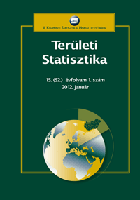Az országgyűlési választókerületek kompaktságának elemzése Magyarországon
Analysis of the compactness of parliamentary constituencies in Hungary
Author(s): Tamás Kovalcsik, György Vida, Gábor DudásSubject(s): Social Sciences, Economy, Geography, Regional studies
Published by: Központi Statisztikai Hivatal
Keywords: electoral geography; constituencies; shape analysis; compactness; electoral system
Summary/Abstract: One of the major topics in electoral geography is the examination of the delimitation of constituencies and the related spatial processes. During the redistricting process, several criteria have to be met, of which the compactness of a given district is one of the determining factors. Shapea nalysis, and in particular, compactness studies provide the mathematical and statistical basis for the examination of this issue. Based on this, the aim of this study is to outline the applicability of international compactness studies in electoral geography and to compare the 1990 (previous) and 2011 (currently existing) Hungarian constituencies in terms of compactness. The results of the research show that the overall compactness of constituencies has not increased due to the smaller number of elements and relatively larger areas. In addition, the study outlines those extreme constituencies in terms of compactness where natural and administrative boundaries have played a role in creating weirdshaped districts, as well as where one can experience result-oriented space shaping. However,the accurate detection of result-oriented redistricting requires the analysis of complex spatial factors, therefore, in order to determine electoral manipulation, it is expedient to extend the number of compactness indicators.
Journal: Területi Statisztika
- Issue Year: 59/2019
- Issue No: 02
- Page Range: 188-218
- Page Count: 31
- Language: Hungarian

